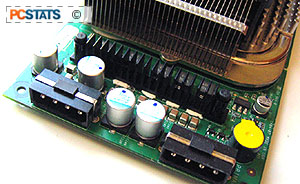 Additional power connectors are nothing new
to videocards, both ATI and nVidia have introduced Molex connectors on their
higi-powered cards, but the NV40 takes this one step above and beyond the
current power requirements. The NV40 draws enough power to require a second
four-pin Molex connector... Add to that the fact that nVidia recommend
a 480W power supply to accommodate the
card's demands on the +12V rail, and users upgrading an older system may be
faced to deal with externalized hardware costs.
Additional power connectors are nothing new
to videocards, both ATI and nVidia have introduced Molex connectors on their
higi-powered cards, but the NV40 takes this one step above and beyond the
current power requirements. The NV40 draws enough power to require a second
four-pin Molex connector... Add to that the fact that nVidia recommend
a 480W power supply to accommodate the
card's demands on the +12V rail, and users upgrading an older system may be
faced to deal with externalized hardware costs.
It should
come as no surprise that the NV40 was natively built to be an AGP card. After
all, there still aren't any PCI Express chipsets on the market, and availability
isn't expected for at least another month or two. When Intel's
i925x Grantsdale chipset does arrive, expect both ATI and nVidia to
introduce corresponding products for PCI Express X16 slots. ATI's will support
PCI Express natively, while nVidia will employ a bridge chip at least until
NV45 is introduced.
The GeForce
6800 Ultra - that is, the 16 pixel-pipeline, dual-slot, dual-power connector
version clocked at 400/550MHz - will debut right around the $500USD mark. nVidia has a variant of the
same card planned as well. The GeForce 6800 is expected to boast 12 pipelines, a
single-slot form factor, a single power connector, and a $300USD price tag. Unfortunately, there's
still no official word regarding that card's operating frequencies yet.
What is Shader Model 3.0?
The current
crop of high-end graphics hardware supports Microsoft's DirectX 9.0 API,
including the Shader Model 2.0 specification. However, the specification has
evolved, and the latest version of DirectX, yet to be released, is being called
9.0c. The primary additions to DirectX 9.0c are Pixel and Vertex Shader Model
3.0, both of which nVidia claims will enable longer programs and consequently
enhanced quality and augmented performance.
Pixel
Shader 3.0 looks to be an evolutionary extension to the 2.0 (and subsequent 2.0a
and 2.0b) specifications. It includes provisions for unlimited dependant
textures and an infinite number of texture instructions. Further, it raises the
maximum number of executed instructions from 512 to 65 thousand, simultaneously
increasing available registers, including four Multiple Render Target buffers,
and requiring dynamic flow control.
Pixel
Shader Model 3.0's final contribution is an FP32 precision requirement, which
NV30 supported, albeit at a significant performance degradation. ATI's new X800
XT videocard on the other hand, is limited to FP24, which is one of the
reasons ATI can't claim Shader Model 3.0 compliance.
The Vertex
Shader 3.0 spec is similarly evolutionary, and also supports programs with up to
65 thousand shader instructions. It offers displacement mapping, geometry
instancing (for rendering multiple objects based on the same model), and vertex
texture fetching. Like the Pixel Shader 3.0 specification, the Vertex Shader
Model 3.0 requires dynamic flow control.
In a
nutshell, the purpose of the new Shader Model specification is to afford
software developers more flexibility and efficiency in writing shader programs.
Naturally, concessions will need to be made in order to ensure acceptable
performance, but it's nVidia's hope that developers will adopt the Shader Model
3.0 specification, where necessary, and put its features to use. These things
don't happen overnight, though, and if a shader can be written using the 1.1
specification, you can be sure that developers will opt for the most broadly
supported spec. Thus, don't expect the benefits of Shader Model 3.0 to surface
immediately.
